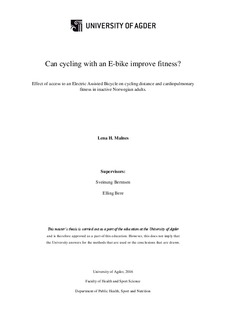| dc.description.abstract | Background:
The aims of the present study were to assess the effect of an eight-month intervention with access to an Electric assisted bicycle (E-bike) on (1) the amount of E-biking, (2) changes in cardiopulmonary fitness and (3) to assess whether cycled distance was associated with changes in cardiopulmonary fitness, among inactive adults.
Methods:
Twenty-five inactive Norwegian adults (33 – 57 years of age, 72 % women), were recruited through convenience sampling. Participants were given an E-bike for eight (N = 23) or three (N = 2) months. Socio-demographic characteristics were reported with a questionnaire. Bicycle use was measured with a GPS bicycle computer and cardiopulmonary fitness were measured as maximal oxygen uptake (VO2 max), before and after the intervention, using a modified Balke protocol to exhaustion.
Results:
During the intervention, cycled distance was 37.6 ± 24 kilometres per week. Participants cycled significantly (P <0.001) more on weekdays (7.1 km/day) compared to weekend days (0.9 km/day). An improvement in VO2 max (7.7 %, P <0.001) from baseline to post test were associated with cycling distance (r = 0.49, P = 0.042). Stratified by cardiopulmonary fitness status at baseline, participants with lower fitness had a significant increase in VO2 max (9.6 %, P <0.001) than participants with higher fitness (1.5 %, P = 0.626).
Discussion:
Access to an E-bike for eight months resulted in weekly 37.6 km of cycling which was positively associated with average 7.7 % improvements in VO2 max. E-bikes may contribute to mobilize inactive individuals to initiate transport-related physical activity.
Keywords
Active commuting, electric assisted bicycle, cycling distance, GPS, maximal oxygen uptake. | nb_NO |
